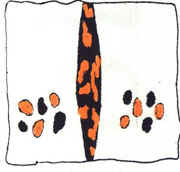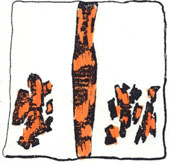by Martha Adams
The Rhinelander was developed in Germany (where else!?!) around 1900 and were first shown in Germany in 1902, although not accepted until 1905. They were first imported to the United States in 1923, sadly the breed disappeared during the war years.
Rhinelanders were again successfully imported into the United States in 1972 and in 1975 were accepted into the ARBA Standard.
Body Type
The standard for the Rhinelander states that first consideration should be give to body type. Even though the Rhinelander is one of the arched breeds, it does have its own distinct type. Judges who may not be familiar with the Rhinelander may be tempted to compare it with other arched breeds such as the Checkered Giant or English Spot. A Rhinelander does not have as an extreme an arch or as long a leg as a Checkered Giant. Its bone structure is medium, with enough length of leg to show daylight underneath, thus allowing the animal to move easily and gracefully down the table.
The body has been referred to as being cylindrical in shape. Shoulders, midsection and hip should be of the same width, creating a smooth topline and sleek appearance. A well rounded hindquarter is required, but there should not be any heaviness of hip. Good length of body is a must, but be sure to fault short coupled specimens. Remember that balance of overall body is also important and should always be considered.
Color and Markings
Moving onto color and markings, most judges are surprised that color and markings carry the same number of points (27). The color points are divided up into 5 points for “body,” that is, the actual color (tone, depth, etc.) and 22 points for balance, or distribution of color. Because all of the markings, with the exception of the cheek spots, are to carry both black and bright golden orange this makes color and markings inseparable.
The markings on a Rhinelander are typical of the butterfly marked breeds. Disqualifications vs. faults vary from breed to breed, so of course be sure to check your standard before you begin judging. The head markings of a Rhinelander are the same as for any other: colored ears, eye circles, cheek spots and of course the butterfly. Good quality markings mean no ragged edges, stray spots or out of balance. The Rhinelander has the added challenge of the two colors being present, (except for the cheek spots) on each marking. The Harlequin markings are not to be evident. For example, look out for one solid golden ear and one solid black ear, or alternating patterns of both colors on the head markings.
Spine Marking
The spine marking is different from any of the other marked breeds. The spine starts narrow at the base of the neck, widens at the shoulder and then narrows again at the base of the tail. It is important to note that the top of the tail is to be completely colored. The edges of the spine marking are to be even, no herringbone effect. Stray spots attached to the spine are faulted, unless of course they go into or touch the side marking, a disqualification.
Side Markings
The side markings of the Rhinelander are probably the one area that causes the most confusion among judges. While the wording of the standard has been reworked to make it clearer, it still seems to be the one part of the Rhinelander standard that judges find hardest to decipher. I’ll try to simplify it.
The side marking is ideally six to eight spots evenly distributed over the hip and loin. Each side is a marking. The spots are components of the marking. A spot is a colored area completely surrounded by white. A spot may be either color or both, but both colors must be present on each side. Congested or patched side markings are a fault, unless there are fewer than three areas surrounded by white, then it becomes a disqualification. Fewer than three spots on a side marking is a disqualification. More often than not a judge will be faced with an animal showing a combination of round spots, and congested areas, also a fault.

This animal has the correct number and placement of spots. It also has very good balance of color. The spots may be black, orange, or both black and orange on the same spot.

A congested side marking is one that has markings running together in a patchwork or solid group. They do not have good clean rounded spots as is desired. Please note that the left side is a disqualification, because it has only two colored areas surrounded by white.
Running
Getting Rhinelanders to run the table can sometimes be a problem. They are not as aggressive a runner as a Checkered Giant and in fact tend to be a “laid back” sort of breed. They are totally non-aggressive in their personality. The Rhinelander should be allowed to move naturally and the standard states, “Let the rabbit pose in its natural position.” Please resist the temptation to move a rabbit down in its class if it does not run; please be patient and observe if the animal will “strike a pose,” as this is what they will do quite naturally. While Rhinelander breeders do train their rabbits to run and pose, it will usually take them a bit to get going. Be aware that some juniors, new to the table, will only “go for a walk,” until they gain confidence.
Since there is not enough time here to go over the faults vs. disqualifications in the Rhinelander standard, I cannot emphasize enough to be sure and read the standard carefully. The Rhinelander is no more difficult to judge than any other butterfly pattern marked breed. Once you are familiar with the standard, who knows you may actually find it is easier to judge than you thought.
